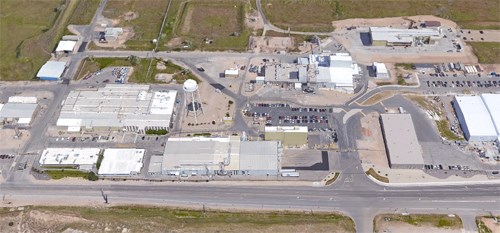The vexing economics of carbon fiber manufacturing
Hexcel's VP and GM Americas, Mike Canario, reviews tough economics the govern carbon fiber manufacturing today, and how they might affect future supply.

This carbon fiber manufacturing facility in Salt Lake City, UT, US, is one of several operated by Hexcel. Hexcel's VP and GM Americas, Mike Canario, talked at CW's Carbon Fiber 2014 conference last week and noted the numerous economic challenges associated with carbon fiber manufacturing expansion.
Mike Canario, VP and GM Americas at carbon fiber manufacturer Hexcel (Stamford, CT, US), spoke at CompositesWorld's Carbon Fiber 2014 conference in La Jolla, CA, US, last week, addressing opportunities and challenges associated with being a supplier of carbon fiber to the composites industry.
Canario provided a rare and frank glimpse of the economics of carbon fiber production and offered revealing insights about how Hexcel sees the market and calculates when and how to expand capacity to meet market demand for carbon fiber.
Carnario noted first that since the mid-1980s, carbon fiber demand in the aerospace industry has been fueled by a variety of important but relatively low-volume military programs, including the B-2, V-22, F-22 and F-35. On the commercial aircraft side, carbon fiber has seen limited use on a variety of Boeing and Airbus planes for many years, but it wasn't until the Boeing 787 and the Airbus A350 XWB were developed that carbon fiber firmly established its place in the aerospace industry. Each plane features carbon fiber in every major structural component (wings to fuselage to tail) and together, at full-rate production, said Canario, will consume more carbon fiber in one year than the F-35 program will over its entire life.
Looking ahead, through 2018, Canario said carbon fiber is expected to growth healthily in ever major market:
- Sports and leisure: 5.7% CAGR (compound annual growth rate)
- Aerospace: 10% CAGR
- Industrial: 14.4% CAGR
- Overall: 12.3% CAGR
What does this mean? Canario said the industry should expect 40,000 metric tons of additional carbon fiber demand in the next five years.
Good, right? Well, yes and no. In short, said Canario, carbon fiber ramp-up is not cheap. Carbon fiber manufacturing requires a polyacrylonitrile (PAN) precursor, the expense of which is exacerbated by the fact that it takes 2 kg of PAN to produce 1 kg of carbon fiber. Further, the high-temperature ovens used to convert PAN to carbon fiber are energy- and capital-intensive. Finally, construction and commissioning of a new carbon fiber plant can take 12 to 18 months, which prolongs return on capital expansion investment.
The real question, Canario said, is this: "Can the current carbon fiber economic model work?" For emphasis, he noted the following costs to manufacture the two basic types of carbon fiber:
- Aerospace grade: $85,000 to $220,000 per metric ton
- Industrial grade: $25,000 to $95,000 per metric ton
Given the current economic model, Canario noted, a carbon fiber manufacturer will expand capacity only if a sustainable rate of return can be guaranteed. This means minimizing risk and capital costs and emphasizing long-term contracts — like that which Toray has with Boeing for the 787 and Hexcel has for the A350 XWB.
For the future, Canario listed several factors that he expects will influence the type and quantity of carbon fiber on the market:
- Alternatives to PAN being developed might prove viable, but will trade performance for cost
- Capital costs will become increasingly important and challenging and will drive much capacity expansion decision-making
- Full use of carbon fiber assets will be the only way to perpetuate the current economic model
- Qualification of carbon fibers for aerospace is time-intensive and represents asset underuse.
"Under-utilized assets are the scariest thing for carbon fiber makers," Canario said.
Related Content
Plant tour: Spirit AeroSystems, Belfast, Northern Ireland, U.K.
Purpose-built facility employs resin transfer infusion (RTI) and assembly technology to manufacture today’s composite A220 wings, and prepares for future new programs and production ramp-ups.
Read MoreManufacturing the MFFD thermoplastic composite fuselage
Demonstrator’s upper, lower shells and assembly prove materials and new processes for lighter, cheaper and more sustainable high-rate future aircraft.
Read MoreASCEND program update: Designing next-gen, high-rate auto and aerospace composites
GKN Aerospace, McLaren Automotive and U.K.-based partners share goals and progress aiming at high-rate, Industry 4.0-enabled, sustainable materials and processes.
Read MoreWelding is not bonding
Discussion of the issues in our understanding of thermoplastic composite welded structures and certification of the latest materials and welding technologies for future airframes.
Read MoreRead Next
“Structured air” TPS safeguards composite structures
Powered by an 85% air/15% pure polyimide aerogel, Blueshift’s novel material system protects structures during transient thermal events from -200°C to beyond 2400°C for rockets, battery boxes and more.
Read MoreAll-recycled, needle-punched nonwoven CFRP slashes carbon footprint of Formula 2 seat
Dallara and Tenowo collaborate to produce a race-ready Formula 2 seat using recycled carbon fiber, reducing CO2 emissions by 97.5% compared to virgin materials.
Read MorePlant tour: Daher Shap’in TechCenter and composites production plant, Saint-Aignan-de-Grandlieu, France
Co-located R&D and production advance OOA thermosets, thermoplastics, welding, recycling and digital technologies for faster processing and certification of lighter, more sustainable composites.
Read More













.jpg;maxWidth=300;quality=90)







